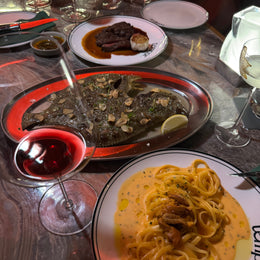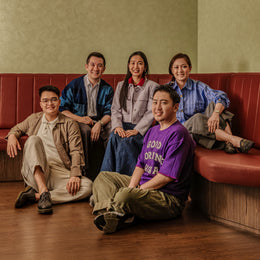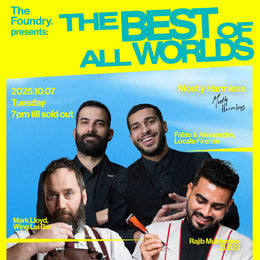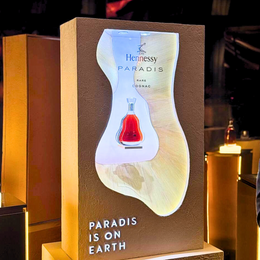
The Highball is said to have British roots - from the accidental invention of soda water in Leeds in 1767, the British were quick to realise that the carbonated beverage paired well with brandy. Then, the Napoleonic Wars saw the British run dry with brandy, and instead "scotch & soda" became the mainstay. The term "highball" was established sometime from the 1880s to the 1900s as the cocktail boomed in popularity in the United States.
![]()
A depiction of the brandy and soda in the 1800s. Source: South China Morning Post

However, the modern love and obsession for the highball could be largely attributed to 1950s Japan - Suntory marketed the Kakubin whisky to be drunk with soda water, marketed with the affable Uncle Tory at Tory's bars. One part whisky, two parts soda water and a wedge of lemon became the standard highball; when topped with a tower of ice in a tall glass, the easy drinking cocktail was the perfect pick-me-up for the afterwork crowd.

The defining look of the Kakubin highball in izakayas - a pint glass, topped full of ice, and with a slice of lemon. Source: Michelin Guide
As is so common within the cocktail universe, the highball would start to have its offshoots, replacing whisky with other spirits and combined with flavours and garnishes. The highball could be a bartender's display of immaculate precision and deliberation behind Japanese bartending philosophy, yet paradoxically, one of the easiest cocktails that could be whipped up by any waiter in the most budget and busy of diners.

Bar Benfiddich sees the Manhattan turned into a highball - the aptly named Manhattan Highball. Source: BAR Times
The revered highball became less of an institutionalized cocktail, but more of a template, in a state of constant evolution from glitzy rooftop bars to crammed izakayas. Yet, the tenets of the highball have remained constant - they're served ice cold, they're (largely) low-proof, and they're meant to be easy drinking.

Just a few streets away from the hustle and bustle of Clark Quay Riverside, Singapore, Neon Pigeon has been at work, and most recently, expanded their beverage menu beyond their core offerings. In this new drinks menu, the bar team has created six new highball cocktails, alongside an offering of two sakes and beer.
![]()
Neon Pigeon is a bold and modern take on the izakaya, dimly lit with neon lights and graffiti-esque wall murals - paying tribute to the dining soul of Tokyo. A while ago, Neon Pigeon has turned 10, where we attended SG Tavern's guest shift behind the bar.

We've been invited back to taste test these highballs - here, Mario la Pietra, the Creative Beverage Director of Neon Pigeon, alongside Bartender Stella, explain the lore behind each cocktail. Let's get to it!
-
Gin Sonic
Roku Gin Sakura Bloom, Umeboshi, Cherry Blossom, Pomegranate, Carbonated Tonic Cordial
The original gin sonic recipe calls for just gin and soda water. Neon Pigeon's take on the cocktail was created by Stella - it happened that the cocktail was created during springtime, which of course had to feature the ubiquitous symbol of the season in Japan. The focus here was to feature the floral elements of the cherry blossom, alongside layers of savouriness from the umeboshi and a hint of bitter from the pomegranate cigar.

The Gin Sonic was Sweet and confectionery - instantly, I was reminded of hard candy that are often on display on the toys section of corner shops - the ones that come in the shape of stars or animals. A whole host of sweet, candied and fruity flavours with an element of muskiness, which is then cut by a refreshing acidity. The cocktail, is a mix of fruity, candied and tart moreishness, which for those who have a slant towards sweeter cocktails, would certainly enjoy this one as the first drink of the night.
Spumoni
Roku Gin, Daiyame Imo Shochu, Campari, Grapefruit Soda, Asahi Foam
This cocktail features a "spuma", which translated from Italian means "foam". In this particular context, spuma is an Italian sparkling drink that is flavoured, often served as an aperitif. Despite the Italian-sounding name, this cocktail was created in '70s Japan, which Mario came to know about in the anime "Bartender".

The Spunomi is a cocktail featuring Campari, Grapefruit Juice and Tonic Water. In t he anime Bartender, the Spumoni prepared during an episode titled “Menu of the Heart,” where its briefly noted as a drink popular with women. (Source: Coqtail Milano )
This creation was also Mario's nod to Ago Perrone's Campari & Birra, with the addition of Daiyame Imo Shochu 25 an inspiration when Mario tried a Spumoni riff at Mizunara The Library Hong Kong by Massimo Petovello - the person who first introduced Mario to the shochu.

The Spumoni was light and floral at first- with aromas of magnolias and peach blossoms. The cocktail has a dry profile, with a moreish mild astringency - probably a result of the grapefruit soda. Retro nasal wise, a lychee aromas surfaces after each sip, followed by a pithy flavour. For a starter cocktail, I think this goes well with heavy dishes, giving a nice crisp finish with the edge if astringency, aptly balanced by a palatable "not too sweet" sweetness - which will be much appreciated by those who don't like sweet drinks.
Chu-Hi
Haku Vodka, iichiko Saiten, Aperol, Lime, Passionfruit Soda, Shiso Salt
As Mario explains, this cocktail is inspired by the ubiquitous Chu-Hai, an abbreviation of shochu and highball and a staple in any izakaya or bar in Japan. Typically, a sweet potato base shochu would be used, then flavoured with (typically) lemon. In this cocktail, Haku Vodka, which is made from rice, and iichiko Saiten, which is made from barley, is used.

The Chu-Hi was sweet and surprisingly amaretto-ish, with a deep, pithy and herbaceous flavour. There's a deep, preserved mandarin and bitter orange flavour in the cocktail - with just a razor thin bittering edge. My partner likened it to a lighter version of a negroni - but to me, reminded me more of a negroni sbagliato. There's an appreciable depth of flavour in this cocktail, and I think the folks who are more used to deeper, bitter flavours might like this one (especially the Aperol Spritz fans!).
Ramune
Kakubin Whisky, Calamansi, Carbonated Yuzu
![]() The classic Ramune is the light blue one, on the left. Source: Tomato Japanese Grocery
The classic Ramune is the light blue one, on the left. Source: Tomato Japanese Grocery
The Ramune needs little introduction - often spotted in TV shows, manga and anime, Ramune is a flavoured soda that is synonymous to Japanese childhood and pop (literally) culture. Mario pays homage to the popular soda drink with this cocktail - fun fact, Ramune is a Japanified enunciation of the word "Lemonade" when the word and drink was first introduced to Japan during the Meiji era.

The Ramune reminds me of an adult, nuanced isotonic drink - the lemony elements are moreish, with a nice subtle fizz and a bitter lemon pith flavour. Tasting this side by side the Chu-Hi, this was a less sweet, more refreshing, and smashable highball. The sweetness is still very much present, like a weak lemonade, with an added complexity of those bitter notes - and I could easily see these being guzzled down alongside Karaage (more on food later!).
Melon Cream Soda
Maker's Mark, Midori, Calpis, Basil, Pineapple, Coconut
![]()
Source: Matcha-JP
Another trip down memory lane - melon cream soda is a uniquely Japanese riff of the American cream soda. In Japanese cafes, melon cream soda is often served in a large towering glass, within it a neon-uranium green melon flavoured soda that's topped with a scoop of vanilla ice-cream. Mario mentions that even though he never grew up in Japan, this flavour combination beckons a sense of nostalgia. In Neon Pigeon's version, the cocktail uses a clarified coconut milk base.

Amongst all the highballs thus far, the Melon Cream Soda was the sweetest, creamiest, richest of the highball! Reminding me of pina coladas, this highball has tropical muskiness, with loads of strong coconut cream aromas and flavours. It's quite milky and rich as well, very similar to sweetened yogurt milks with a confectionery aftertaste. This cocktail makes for a dessert on its own - and for those who aren't sweet-tooths, I do advise letting this cocktail dilute slightly over the ice.
Mizuwari
Hibiki Harmony, Tomato, Banana Water
The Mizuwari is as simple and purist as it gets: breaking down the name of the cocktail, "mizu" meaning water and "wari" meaning "cut", the mizuwari is simply whisky cut with water (and ice). Yet another Japanese classic, Mario discovered this cocktail back in 2009 in a Japanese masterclass by then global Brand Ambassador for Nikka Whisky.
Mario also references the Mizuwari back to the Bartender series (anime or manga). The Mizuwari is the very first featured cocktail by the protagonist of the Bartender manga (and anime) Ryū Sasakura - his choice of cocktail to serve to a tired, burnt out hotel beverage director after sharp observation.

Chapter 1: A Tender Stool, Pg 32. I really am a fan of the manga. And I am so glad Mario is a fan of the series as well.
Here, the water is replaced with tomato and banana infused water.

The aromas of the cocktail was sweet and fruity- a mix of Cavendish bananas and grain whisky. The cocktail itself is sweet, umami, mildly vegetal, bittering and strong as well - vaguely reminding me of watermelon chewing gum. This is the strongest of the highballs (to me, this is more akin to a [that cocktail with hot beef broth], but the cold version).
Personally, I prefer to let this cocktail water down and take it slow - if I could suggest, ordering it as a mid course drink and enjoy with heavier entrees or when the conversation is picking up. After dilution, the cocktail gets less bittering and vegetal, instead revealing more banana flavours and aromas.
Closing Thoughts
For a barhopper who struggles with post-work fatigue more often than his ego would like to admit, I can't be happier that there's more attention paid to the humble highball. Neon Pigeon's offerings were tasty, delicious and deliberate, yet the complexity of the cocktails don't take away from the essence of a fizzy, light and refreshing drink. Definitely head down and try the cocktails when you can - and give a fistbump to Mario for sharing his inspirations for the add-on menu!

@vernoncelli
36 Carpenter St, #01-01
Singapore 059915
P.S. Go read the Bartender manga - whilst there may be some minor inaccuracies in the lore and history for some of the cocktails, the over-arcing story and romanticisation of the bar counter makes for a good slice-of-life read, if anything. Along the same vein, I'll also recommend Sleepy Barmaid, though I am guilty of not keeping up with the manga series in a while.
-
Now, remember the core tenets of the highball? Culturally, drink must almost always be accompanied with food in Japan, so much so that there's a symbiosis between the food-drink pairings. With easy to drink, refreshingly cold highballs, it would be criminal to not have any food to go with it!
The food menu at Neon Pigeon has underwent some updates as well - and perhaps Mario could sense our hesitant deliberation on what to order with our drinks. Mario offered to pick out the night's menu for us, and we were more than happy to go with his recommendations. Let's go bullet-style and review the tasty spread:

Edamame Hummus: Edamame, Curry Chips
The Edamame Hummus was the first dish of the night - hummus afficiandos would immediately notice that this hummus was more on the creamier, nuttier side. The hummus was rich with tahini flavours, with much needed pops of contrast from the furikake sprinkled over the top. Paired with buttery curry chips, this dish was extremely satisfying and satiating, and my recommendation if you had to only pick one bar snack to have at Neon Pigeon.

Chuu-Toro Tataki: Wafu Dressing, Onion, Wakame
Next up was the Chu Toro Tataki - and this was a sweet, mustardy umami bomb! The pungent onion really brings a much needed pop of heat and freshness, which by contrast really lets the sweetness of the tuna shine the more you chew on it. The wakame salad also brings a textural crunch and freshness to the otherwise flavour-heavy dish, perfectly rounding it off.

Duck Gyoza: Foie Gras, Orange Ginger Ponzu
Duck Gyoza was our first hot dish. The duck gyoza was straight to the point and uncomplicated, with smooth ground meat filling and a crisped dumpling skin. It's simple and nothing overtly complex, but familiar, satiating, rich in meaty flavours and generous. The accompanying sauce wasn't too vinegary or tart either, with a nice salty savouriness sweetness. I would suggest this for folks who are looking for a safe and reliable dish, but personally, I thought this dish was a bit too safe for comfort.

Karaage Chicken: Crispy Chicken Thigh, Sansho, Citrus
Next up on hot dishes was the Karaage Chicken - similarly, it was simple, uncomplicated, and for once resolving the biggest gripe with karaage - fried in a batter that isn't overbearingly salty! I appreciate how the leaner saltiness really allows for the chicken flavour to shine, and the batter is adequately spiced enough to add a ticklish heat, with a sprinkling of pepper to round it all off. If I had to nitpick, I felt that the single wedge of lime wasn't enough to season all the meat pieces, and an additional wedge or a small ramekin of vinaigrette would edge it that much closer to five stars for me.

Hamachi: Wasabi, Watercress Miso, Pickled Shallot, Pomelo
Going back to cold dishes, the Hamachi was next. Mario mentioned that this is Neon Pigeon's signature dish at every guest shift they attend, and the Hamachi is always the first to go. The dish interestingly accentuates sweetness and the umami, cured and almost jammy flavours of the hamachi - together with that watercress miso adding a much needed freshness. Pop of pomelo adds a burst of acid and juiciness that completed the dish - which, whilst rather lean in tartness, did not feel cloying or overbearing.

Wasabi Scallop: Hana Wasabi, Soy, Tapioca Chips
The next dish was the Wasabi Scallop - and right off the bat, the texture of that scallop was mind blowing! Spoon-soft tender texture, which was buttery and rich in crustacean sweetness. The scallops were super chew-some, alongside with that addictive sweet, spicy wasabi marinate. The wakame completes the dish with an textural and plain-cleansing freshness. As a tako-wasabi enthusiast, I appreciate how the wasabi is quite present in the wakame salad and sauce. Out of all the sashimi dishes, I think this one is my favourite (I do have a bias towards shellfish).

Menchi Katsu: Minced Wagyu, Curry Mayo, Katsu Sauce, Pickles
Ending off the spread was the Menchi Katsu. The meat patty has a lightness to it, which prevented it from feeling too cloying. The katsu sauce added a nice , BBQ-sauce acidic zing to the patty. However, when paired with the crusty bread, the sauce becomes more buttery and rich, almost like McDonald's curry sauce for nuggets.
For my personal recommendations, I'll definitely pick the cold dishes - the Hamachi, the Wasabi Scallop are my top two favourite dishes throughout! A special shoutout goes to the Edamame Hummus as well - the snack is so smashable and quite generous in portion, and is something I could see ordering multiples of when at Neon Pigeon.







